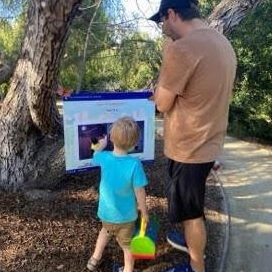Exploding white dwarfs make the calcium in our bones. Dying massive stars release the iron that makes our blood red. Smaller dying stars and red giants produce the essential elements of life: carbon and oxygen. As someone who began their science journey immersed in science fiction, theoretical astronomer A/Professor JJ Eldridge has certainly learned that there is life among the stars, as we are all made of stardust. At the first RSV lecture held with Queers in Science to celebrate the 2020 Midsumma Festival, JJ shared their personal story in breaking the gender binary, reflecting that while they are personally a non-binary individual, their research focuses on the evolution of binary stars.
Dr Rajesh Ramanathan combines nanoparticles with light to achieve a wide range of biomedical applications. From sensing chemicals and bacteria, to healing wounds and imaging patients, his nanotechnology is at the forefront of biomedical science and its potential is endless. Winner of the 2019 Phillip Law Postdoctoral Award for Physical Sciences, Dr Ramanathan shared his journey to incorporate elements of nature into the design of nanoparticles for a wide range of biomedical applications. By shining a light on patients and nanoparticles, he can reveal their glucose levels, repair their wounds, and image their tumours.
Current climate models cannot capture the persistence of drought and length of heatwaves, and they struggle to simulate future rainfall extremes, sometimes because they offer conflicting results, because climate prediction and greenhouse gas emission models are not just in the hands of climate scientists. They have to take the human population into account – demography, economics, technology, and our actions. The modelling of future carbon dioxide emissions provides multiple possible futures depending on these. Professor Andy Pitman asks “what do you want for your future? Which do you think we can achieve?”
Among epileptic patients, 70% are effectively treated with drugs and live a generally normal life, but the other 30% are resistant to these drugs. Some can get around this by having invasive surgical procedures. Yet despite progress of the last 30 years to improve epilepsy treatment, the percentage of patients who cannot be treated remains at 30%. One of the most debilitating aspects of epilepsy is the uncertainty of when a seizure will occur – even if they are as infrequent as two a year. If you don’t know when the seizures will come, you cannot know when you are safe. Professor David Grayden wants to predict the onset of seizures, which could change the lives of over 15 million people.
The contribution of Dr David Maughan Churchill to the life and leadership of our Society has been significant, not just as one of our four Trustees, but also as our President from 1983 to 1984. David’s election was a meaningful moment in our long succession of science community leaders, as his corresponding tenure as the Government Botanist of Victoria and Director of the Royal Botanic Gardens (RBG) recalled the role and contribution of our first (Royal) President, Baron Sir Ferdinand von Mueller, in 1859, and perpetuated the long relationship between the RBG’s scientific leadership and the RSV.






